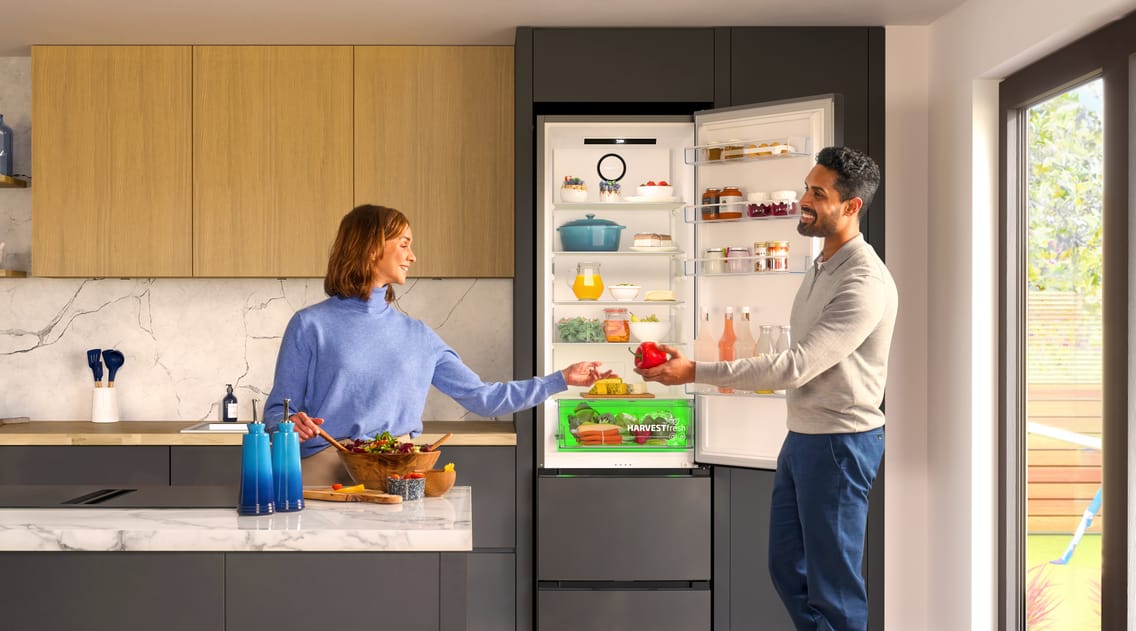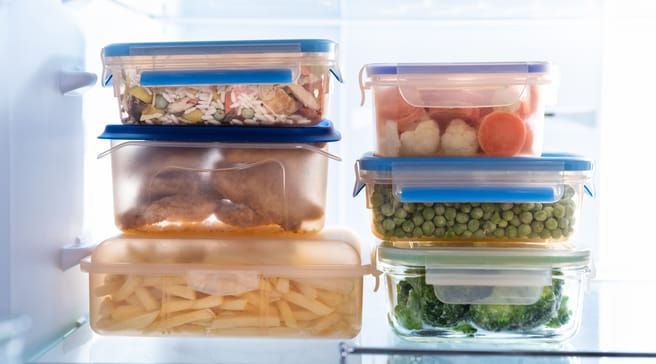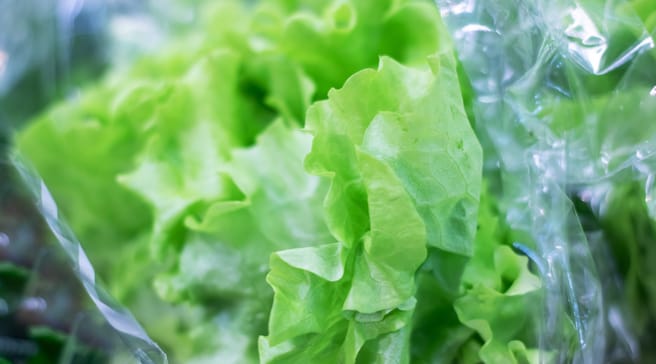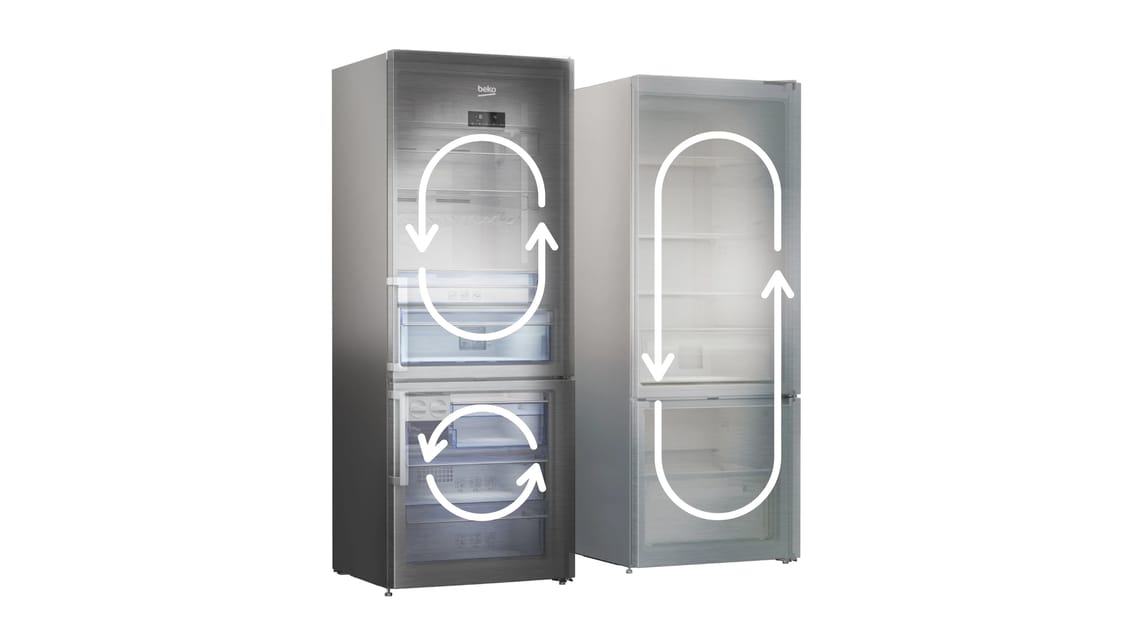Difference between fridge and freezer temperature
Fridges and freezers are essential for food storage, but their roles and temperature settings differ significantly. While the most obvious distinction is their operating temperatures, there are other key factors to consider.
In this guide, we’ll not only explain the optimal temperature settings for fridges and freezers but also explore how modern technologies, such as NeoFrost™, can enhance their efficiency. Understanding these differences is crucial for maintaining food safety, freshness, and longevity.
What is the Ideal Fridge Temperature?

A fridge helps preserve the freshness of food and drinks by maintaining a cool, controlled temperature. To ensure it operates efficiently, safely, and cost-effectively, it’s essential to maintain the optimal temperature and be aware of common mistakes that could impact food preservation.
Recommended Temperature for a Fridge
The optimal fridge temperature is between 3°C and 5°C. This range helps prevent bacterial growth, keeping food fresh and safe while also ensuring that delicate items like fruits and vegetables don’t become too cold or start to freeze. Maintaining this temperature balance is key to preserving food quality and reducing waste.
Key Considerations for Optimal Fridge Usage
- Top and Middle Shelves: These shelves are best for ready-to-eat foods, like leftovers or dairy products such as butter or cheeses.
- Bottom Shelves: It is generally considered that the bottom shelves of a fridge are the best space for raw meat and fish due to the cooler temperatures associated with the section of the appliance, and the lesser chance of leaks of the juices from the raw products.
- Crisper Drawers: These drawers are designed to help your fruits and vegetables thrive in higher humidity.
- Door Shelves: Since the fridge door is the warmest area due to frequent opening, it’s best suited for condiments, juices, and other non-perishable items.
For a detailed guide on how to organise your fridge efficiently, including tips on temperature zones and food safety, check out our full fridge organisation guide.
What is the Ideal Freezer Temperature?
While fridges are designed to keep food and drinks fresh for short-term use, freezers provide long-term storage by freezing food and halting bacterial growth.
Just like a fridge, a freezer must be set to the correct temperature to ensure frozen goods remain preserved safely and maintain their quality over time.
Recommended Temperature for a Freezer
The ideal freezer temperature is -18°C, ensuring food stays safely frozen while preserving its texture, taste, and overall quality.
Key Considerations:
 Avoid Overloading
Avoid Overloading
Like the fridge, you should avoid overpacking the freezer as this has the potential to block air circulation, which can cause fluctuations in the temperature and affect the longevity and quality of the products in the freezer.
 Sufficient Packaging
Sufficient Packaging
If you are not freezing in the packaging the foods come prepared in, then it is advisable to use airtight containers or freezer bags to prevent freezer burn.
 Freezer Compliant Goods
Freezer Compliant Goods
Not all foods are suitable for freezing, so it’s important to check the packaging for storage guidelines. Look for instructions on when to freeze the item after purchase and the recommended consumption period to ensure optimal quality and safety.
The Importance of Maintaining Separate Temperatures
Fridges and freezers have distinct temperature requirements due to the types of food they store and their specific purposes.
A fridge prevents spoilage by keeping perishable items fresh, while a freezer halts microbial growth by freezing food for long-term storage.
If the temperature is set incorrectly, it can lead to bacterial growth and food spoilage if too warm, or unwanted freezing in the fridge and freezer burn in the freezer if too cold.
What is NeoFrost™ Technology?

Beko’s NeoFrost™ technology is an advanced cooling system designed to enhance the performance of both your fridge and freezer.
By utilising separate cooling systems for each compartment, NeoFrost™ ensures optimal temperature and humidity levels.
How Does NeoFrost™ Works?
NeoFrost™ technology features dual cooling systems that independently regulate the fridge and freezer, preventing air exchange between the separate compartments.
With higher humidity levels in the fridge, NeoFrost™ not only helps preserve food for longer but also prevents odour transfer, ensuring your ingredients stay fresh and flavourful.
Advantages of NeoFrost™ Technology
The NeoFrost™ technology offers a variety of benefits over traditional cooling systems, such as:
- Prevents Odour Mixing: The separate cooling systems of the NeoFrost™ technology mean that those stronger-smelling foods, such as cheeses or fish, don’t transfer any odours to the freezer section of the appliance.
- Faster Cooling and Freezing: NeoFrost™’s dual systems enable faster cooling in the fridge and quicker freezing in the freezer.
- Prevents Ice Build-Up: With NeoFrost™ technology, the freezer maintains a dry environment, preventing ice build-up and eliminating the need for manual defrosting. This ensures efficient cooling while keeping your frozen foods in perfect condition without unwanted frost.
Why Your Next Fridge Freezer Should Have NeoFrost™ Technology
With innovations like NeoFrost™ technology, managing fridge and freezer temperatures has never been more efficient or precise. Its dual cooling systems and advanced humidity control create the perfect environment for preserving food.
Investing in a NeoFrost™-equipped appliance, such as Beko’s NeoFrost™ American Style Fridge Freezers range, offers multiple benefits including extended food freshness, prevention of odour transfer, and an all-round enhanced kitchen experience.
Whether you're storing fresh produce, meats, or frozen items, NeoFrost™ technology ensures the ideal storage conditions, keeping your food at its best.



